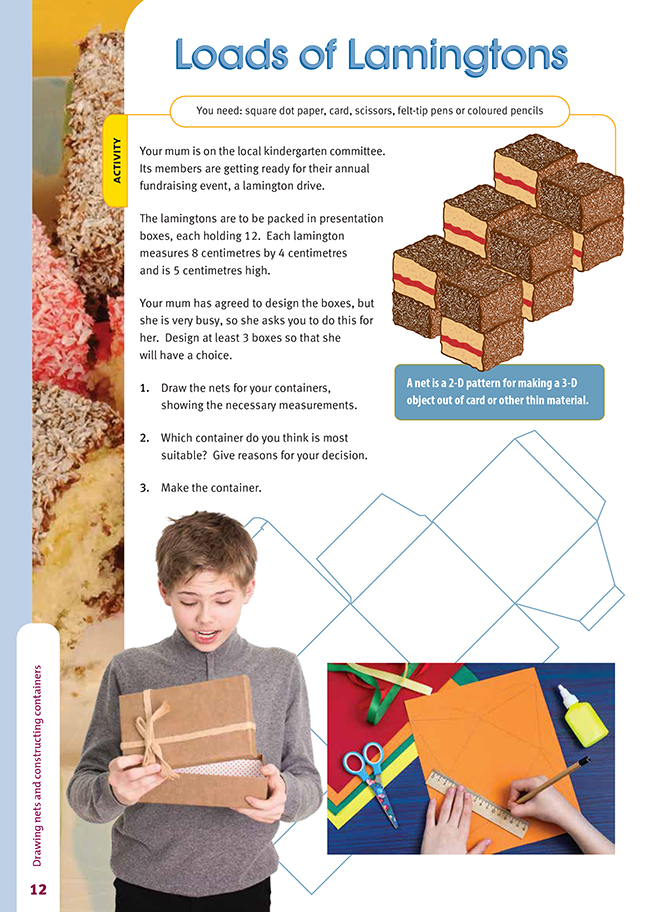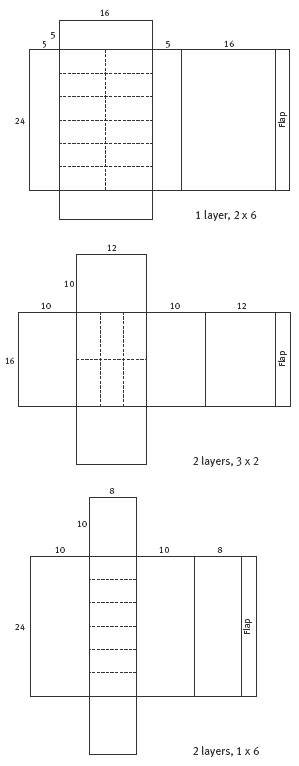This is a level 4 geometry strand activity from the Figure It Out series.
A PDF of the student activity is included.
Click on the image to enlarge it. Click again to close. Download PDF (2.2 MB)
draw a net
FIO, Level 4, Geometry, Book One, loads of Lamingtons, page 12
square dot paper
card
scissors
felt-tip pens or coloured pens
This activity fits with a level 4 suggested learning experience: "Students should be investigating the construction and use of packaging and containers (including regular polyhedra) in the commercial world, for example, to minimise wastage, and for stacking (tessellating end faces)."
The design of nets for boxes and packets is a sophisticated skill that can make or break the success of a product. Consumers will usually choose an attractively packaged product ahead of a poorly packaged product, even if they know that they will throw the packaging away the moment they get home. You may be able to
show your students examples of attractive and different packaging opened out to reveal the net.
If your students have had little prior experience designing nets, they could begin with nets for a cube. By doing this, they will see that there can be different ways of designing a net that will fold to give the same
result. The net for a cube is made from 6 squares because a cube has 6 square faces. Your students may wonder if any combination of 6 squares will give the net of a cube. (It won't.) You may like to challenge them to find all the possible different nets. (Rotations and reflections don't count as different.)
If you begin with the net of a cube, you will also be able to demonstrate and discuss design and assembly techniques. You can talk about the importance of providing gluing tabs, cutting tidily, scoring lines before folding, and using sparing amounts of PVA to make a neat join. Your students should then be able to manage the more complex task.
When designing the boxes for the lamingtons, the students should remember that the box must have a lid with a flap, and although this is not part of the net, they may also consider what else could be part of the packaging. For example, should there be a paper liner, a separator between layers, or an outside wrapper?
Different-sized containers are possible, depending on how the lamingtons are arranged. The students could work in pairs on the design activity, beginning by spending time considering the different options, discarding all but three, and being able to justify their decisions.
The Answers contain nets for three possible boxes. Students will realise that the dimensions shown are the absolute minimum and would result in a very tight fit for the lamingtons. They may wish to design their nets with slightly larger dimensions in each case. Some products, such as biscuits, do not require extra space. In fact, they travel better if they are in boxes or packets where there is a tight fit. This is probably not the
case with lamingtons.
Answers to Activity
1. There are numerous possibilities, some of which are impractical. Three possible nets are:
2. Answers will vary. Factors to consider include how easy it is to make the container, how effectively it will display the contents, and how easy it will be to
pack and remove the lamingtons without damaging them.
3. Practical activity


